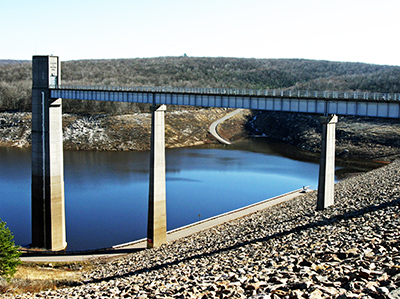Delaware • New Jersey • Pennsylvania
New York • United States of America
 |
| The Francis E. Walter Dam & Reservoir is located on the Lehigh River in Carbon & Luzerne counties, Pa. It is owned/operated by the U.S. Army Corps of Engineers (USACE), Philadelphia District. Photo courtesy of the USACE. |
F.E. Walter Dam
The Francis E. Walter (F.E. Walter) Dam was completed in 1961, with the single purpose of flood control; in 1988, Congress added recreation as another authorized purpose. It is one of five reservoirs owned and operated in the Delaware River Basin by the U.S. Army Corps of Engineers (USACE).
Study Lead & Co-Sponsors
The F.E. Walter Dam Re-Evaluation Study is being led by the USACE. The DRBC, as well as the NYC Dept. of Environmental Protection (NYCDEP), are non-federal co-sponsors of this study.
Study Purpose
The intent of this study is to determine if modifications to the F.E. Walter Dam structure, infrastructure, or reservoir operations can be implemented to improve water supply, fisheries, recreation, and other objectives - especially during drought conditions - without adversely impacting the congressionally authorized purposes of the reservoir, which are flood risk management and recreation. Any changes to those Congressionally-authorized purposes need Congressional approval.
Why is the DRBC Involved?
As the primary manager of the Delaware River Basin's water resources, the DRBC works to ensure there is ample, clean water in the Basin for all those who depend on it; that includes people, industry/business (incl. recreation/tourism businesses) and aquatic life. Additionally, the F.E. Walter Reservoir is included in DRBC's Comprehensive Plan.
DRBC's role as a non-federal sponsor of this study ensures all Basin states are represented in the process. The Commission supports the re-evaluation study and also supports the existing uses of the reservoir, recognizes their value to the region and to the Basin and believes those uses should be protected. Finally, DRBC supports the public input process. It is critical that the study team understand the water resources needs locally in the Lehigh Valley. We always should be willing to consider ways to optimize, improve and better balance multiple water needs. Can F.E. Walter be better managed for the Basin? Can recreational opportunities on the Lehigh River, for example, paddling and fishing, be enhanced? Looking out 40, 80 years, will there be enough water in the Basin to support all needs? Even during drought emergencies?
The Commission also recognizes it is wise to study all of the Basin's reservoirs to see if they are being managed and operated optimally for present and future water storage needs. In April 2023, the DRBC released a review of future water storage options, Evaluation of Additional Storage in the Delaware River Basin. Learn more about this report. Staff is also looking at water demands, water availability and resiliency throughout the Basin.
Why is the NYCDEP Involved?
The NYCDEP owns three large water supply reservoirs at the headwaters to the Delaware River Basin in New York State. These three reservoirs are managed through a 1954 U.S. Supreme Court Decree; changes to their operation and management have occurred since 1954, but only with unanimous consent of the five decree parties (Delaware, New Jersey, New York City, New York State, and Pennsylvania). In fact, specifically focusing a feasibility study on the F.E. Walter Dam is included in the 2017 Flexible Flow Management Program (see page 7; pdf), which is the most current management plan for these reservoirs.
F.E. Walter Dam Re-Evaluation Study: September 2024 Update
The study is ongoing and expected to be completed in 2027. In September 2024, study partners gathered at DRBC's office to sign a feasibility cost-sharing agreement amendment for the study, which will provide adequate time and resources to complete a full re-evaluation. This includes additional environmental modeling and engineering analysis to examine existing and future use of the Francis E. Walter Dam Reservoir during Delaware River Basin emergency drought conditions to support/aid salinity repulsion in the Delaware Estuary, provide low flow augmentation and protect aquatic life.
- View USACE news release announcing the signing of the cost-sharing agreement amendment (September 18, 2024)
- View DRBC newsbyte about the signing ceremony
To date, only the study is funded; no funds are yet allotted or appropriated for anything else.
Public Input
Public input is important, and any potential recommendations that come out of the study will be considered in light of that, as well as weighed against economic and environmental impacts and the technical feasibility of any changes. The public can comment on the study throughout the process; information can be found at the below link.
Additional Resources
- USACE Study Fact Sheet (pdf)
- USACE FAQ Document (pdf)
- DRBC Resolution for the Minutes (pdf), unanimously approved by the Commissioners on March 13, 2019, which authorizes the DRBC Exec. Dir. to enter into a Feasibility Cost Sharing Agreement with the USACE to fund a scoping study for the reevaluation study.
Copyright © Delaware River Basin Commission,
P.O. Box 7360, West Trenton, NJ 08628-0360
Phone (609)883-9500; Fax (609)883-9522
Thanks to NJ for hosting the DRBC website